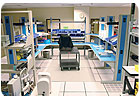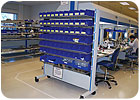
During a soft economy, some manufacturers look the other way when it comes to ergonomics. Unfortunately, the risk of injury is a constant threat on assembly lines-it’s not something that goes away when times get tough. In fact, some experts argue that a sound ergonomic strategy makes more sense than ever in a slow economy, because it leads to less fatigued workers, lower insurance costs and less downtime for injured employees.
Ergonomics has always played a key role in cost-effective workstation design. However, some signs indicate that it has taken a backseat in recent years, especially compared to earlier this decade when ergonomics was a hot-button issue.
In November 2000, the U.S. Occupational Safety and Health Administration (OSHA, Washington, DC) announced a sweeping ergonomics proposal. But, the controversial Clinton administration ergonomics rule was repealed in Congress shortly after George Bush became president in early 2001. In April 2002, OSHA unveiled a revised ergonomics plan that focused on developing guidelines for reducing repetitive-stress-related injuries.
Since then, ergonomics has assumed a lower profile, with fewer repetitive strain cases being reported. The National Council on Compensation Insurance Inc. (NCCI, Boca Raton, FL) claims that the frequency of carpal tunnel syndrome claims has fallen over the past decade. That phenomenon may be directly connected to all the proactive steps that manufacturers took to ensure that their assembly workstations addressed ergonomic issues and concerns.
“Some companies reactively implement an ergonomics program due to cumulative trauma disorders, absenteeism, high turnover or poor product quality,” notes Kurt Greissinger, product marketing manager at Bosch Rexroth Corp. (Buchanan, MI). But, he says manufacturers typically launch proactive ergonomic campaigns when they are faced with the threat of government regulations, which was the case earlier this decade.
“Today, managers have a greater appreciation and understanding of the value and the insurance ergonomics provides,” adds Erica Rice, marketing director at Production Basics (Watertown, MA): “They are considering ergonomics upfront when initially evaluating workstations and other human-intensive equipment. Seven or eight years ago, there used to be a lot more retrofitting and thinking about ergonomics as a reaction to problems.”
Ergonomics is now more common and better understood than it was 10 years ago. “It is expected to be incorporated into workstation design,” says Bob Simmons, national sales manager at Pro-Line (Haverhill, MA). “Seven or eight years ago, some customers would ask if we offered an ergonomic bench. Today, customers ask questions such as, ‘What makes your workbench ergonomic?’ Ergonomic workbenches are becoming more the norm.”

Mainstream Activity
“The difference between now and then is that there’s a better understanding of the topic today on both sides-manufacturers and end users-and that basic ergonomic features are now found in many products,” says Louise Lanctot, vice president of marketing at Workplace Systems Inc. (Londonderry, NH). “Everyone is aware of the necessity and benefit of building as many good ergonomic principles into a work process as possible. So, it’s more of an unspoken given that ergonomics is at the forefront when designing a new workstation for a specific function.“More than ever, companies are looking for workstations that are designed with the features they need to provide ergonomically correct work areas for their employees,” Lanctot points out. “It’s as much about what they’re doing on the workstation as the workstation itself, so they’re asking questions about the flexibility and adjustability of the product, which are both essential in the design of ergonomically correct work processes.”
According to Duff Elleby, president of Ergosource Inc. (Wayzata, MN), some of the “ether” that once surrounded ergonomics has worn off. “Years ago, ergonomics had a certain gee-whiz factor to it,” he explains. “In those days, we attempted to sell ergonomic concepts to a health or safety manager who would, in turn, sell it to top management. Today, manufacturing engineers automatically implement ergonomic concepts into their processes.”
“Ergonomic designs and principles have become ingrained in our daily lives,” adds David Verrill, applications support manager at IAC Industries Inc. (Brea, CA). “When the word ‘ergonomics’ came onto the scene, it was a genuine rarity in many manufacturing facilities.
“That’s not true at all anymore, and I think companies of all sizes have benefitted,” notes Verrill. “In today’s world, even the small shop with four operators using inexpensive benches is experiencing the rewards only previously afforded by the big spenders.”
“There have been improvements [in workstation design] over the years, but I don’t really think the core ergonomic principles have shifted,” Verrill points out. “The overall goal is still to design a useful workstation that caters to an operator’s physical build, working comfort and any possible limitations.”
Unfortunately, the health risks that are caused by repeated motions on assembly lines, such as carpal tunnel syndrome, tendinitis and lower back pain, have not disappeared as ergonomics has become more widespread. And, as the U.S. workforce gets older, the number of incidents may start to rise again. Indeed, NCCI data indicates that carpal tunnel syndrome claimants tend to be older and that the severity of the incidents often rises with age.
“An important trend to consider is the aging workforce,” explains Greissinger. “As the average working age increases, correctly designed ergonomic workstations would not necessarily require change to accommodate the workers.
“What would require consideration are the cumulative stresses and loads that a person experiences throughout the course of a workday,” says Greissinger. “If the products being handled cannot be made lighter, then the frequency and duration of the handling must be reduced to accommodate the loss of strength and bone density.”

Lean Influence
In recent years, ergonomics has become less of a standalone discipline and more of a lean manufacturing initiative. “Ergonomic principles are consistent with the goals of lean manufacturing, such as waste reduction and simplified movement,” says Elleby. “Lean manufacturing focuses on using the minimum amount of resources to complete a project on time.”
Quarterman Lee, president of Strategos Inc. (Kansas City, MO), says lean elements, such as cellular production, 5S and visual controls, all address ergonomic issues. “Ultimately, value is added at the workstation level where products are built,” Lee points out. “Eliminating waste here is just as important as eliminating it through inventory, material handling and other areas.”
To address lean initiatives, manufacturing engineers are looking for flexible, modular workstations that can be easily reconfigured. For instance, legs equipped with casters are essential.
“Every workstation has to be mobile,” says Rice. “And, everything on the workstation has to be easily adjustable. It’s not just a wrist rest or a footrest. Drawers, monitors, shelves, dividers and bins all need to be easy and comfortable to use.
“Height adjustability is also key,” adds Rice. “Manufacturing managers are serious about budgets, return on investment and efficiency. Electrically or hand crank-operated workstations serve several practical purposes. These workstations can be used by different employees throughout the day without sacrificing comfort and safety. Even as a dedicated workstation, the operator has the ability to adjust it to various tasks and how they are physically feeling that day.”
Workstations must now be designed to accommodate a variety of workers, because lean production typically encourages sit-down, stand-up or stand-up and move methodologies. “This provides the most flexibility in a lean environment, while allowing employees to move through a range of motion that doesn’t encourage repetitive stresses on the body,” notes Greissinger. “Workstations made from T-slotted aluminum framing are often a good choice, because accessories can be placed anywhere along the T-slot. That allows the workstation to be tailored perfectly to the needs of each worker.”
The ability to easily install or remove a wide range of accessories and components is also an important consideration in today’s lean world. “An expansive selection of overtable and undertable accessories, such as adjustable storage shelves, bin rails, power, lighting, drawer storage, tool rails, pegboards, storage panels and computer peripherals, are essential in the design of lean workstations,” claims Lanctot. “End users are looking for the ability to purchase and add accessories as they need them, when they need them.”
Paperless work instructions are another lean-inspired trend that’s influencing workstation design. They allow operators to access and view standardized information with a computer display. Paperless systems save a tremendous amount of time and eliminate waste, because information does not have to be manually typed in from hand-written notes.
“With the introduction of monitors and computer components to replace paper work instructions, we have seen an incredible surge in related accessories,” says Verrill. “Slide-out, swiveling CPU holders and fully-adjustable flat-panel screen holders are a part of nearly every job we build lately.”
The challenge in going paperless is finding space at the workstation for the components that replace the paper system, such as a computer monitor. “The electronic components need to be part of the workstation without infringing on prime work space, while at the same time adhering to sound ergonomic principles that position these new work tools correctly in relation to the user,” warns Lanctot. “Also, any time you add something new to a workstation you have to consider how it will impact what you’ve already accomplished in terms of an ergonomically friendly work area. It’s a continual process.” A
To learn more about workstations and ergonomics, search for these articles on ASSEMBLY’s Web site:
- Does Going Paperless Work?
- Ergonomics: Ford Simulates.
- Ergonomics: Honda Innovates.
- Ergonomic Milestones.
- Get Ready for ‘Ergobamanomics.’
- Glossary of Ergonomic Terms.
- Lean Workstations: Organized for Productivity.
- Lighting the Way to Lean.
- The Pros and Cons of Cells.

